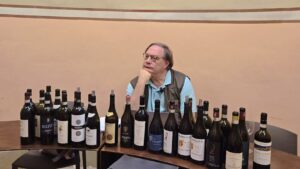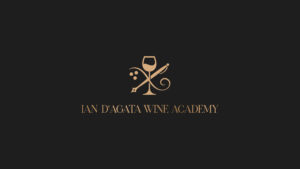Le Calandre
Via Liguria, 1
35030 Rubano (near Padua)
Italy
Tel. +39 049630303

The dishes
Spring al Aimo (Al Aimo di Primavera) – a dish in hour of Aimo Moroni
Cuttlefish Cappuccino (Cappuccino di Seppie al Nero)
Napul’è per Alfonso Mattozzo
Suono n’Uovo
Risotto Passi d’Oro (A variation of our saffron and licorice risotto dedicated to Roberto Barni’s sculpture at the Uffizi Gallery)
Scorched Bone Marrow With Calamari Cream, Sea Urchin And Amur Dauricus Caviar Bruschetta (Osso Incendiato con Bruschetta di Calamari, Ricci e Caviale Amur Dauricus)
Roast Suckling Pig, Chicories Mustard And Coffee Powder (Maialino, Cicorie, Senape, Caffè)
Almond Mozarella (Mozzarella di Mandorle)

Is Le Calandre Italy’s best restaurant? There are many food experts whose palate I trust who believe so, and for them, it’s not even close. Those who prefer traditional takes on their food will vote for Dal Pescatore, but it’s certainly a close fight: they are two of the very best restaurants in the world, never mind Italy, and we’ll just leave it at that.

Alajmo hangs its hat on the amazing talent of Massimiliano Alajmo, who, in 2002 at 28 years of age, became the youngest ever winner of the coveted three Michelin stars and whose cuisine is a remarkable balance of lightness, purity and depth. The man has been blessed with crystalline talent, and even more to his credit, is neither a boor nor an ignoramus, as some of his colleague who grace TV screens everywhere seem hell-bent on appearing. I first met Alajmo and ate at his restaurant when he did not yet have two Michelin stars: I wasn’t yet reviewing restaurants, and was just a foodie going to as many good ones I could, either on my own or with my mother who never turned down an opportunity to eat well (I actually began writing professionally about restaurants only a few years later, for the Gambero Rosso Guida ai Ristoranti d’Italia). I always felt the man would know skyrocketing-like success and so I wasn’t surprised when the accolades came flying his way (though the Gambero, that I had left by then, initially missed out on recognizing Alajmo’s talent and greatness, while Michelin did not). It’s always a pleasure to sit back and listen to this charming, soft-spoken, acute, insightful, knowledgeable man, and even better, to taste his cuisine, now made up of a series of new dishes as well as truly classic ones, such as the Cuttlefish Cappuccino (Cappuccino di Seppie al Nero) or the fried spaghetti-wrapped shrimp with a green lettuce emulsion (the latter is a reference to one of Alajmo’s many creations of the early 2000s, but is currently not on any of the menus). Suffice it to say that I so like the man’s cooking that I have actually learned to cook some of his dishes: yes, I can actually make a pretty good cuttlefish cappuccino, though clearly, it’s nowhere near as good as the master’s.

But Le Calandre is not a one-man show: in fact, its success hinges on the remarkable Alajmo family, a series of winners if there ever were. Le Calandre opened its doors in 1981, the brainchild of Erminio Alajmo and Rita Chimetto. In 1994, their two sons, Massimiliano (Max to his friends) and Raffaele (or Raf, for just about everyone who knows him) took over: Massimiliano planted his flag in the kitchen and Raf did the same in the dining room, but the latter was actually the financial and organizational mind (he is now the CEO of the Alajmo group), along with the rest of the family including their sister Laura, behind the restaurant’s surge to fame and its expansion into restaurant empire. Since Le Calandre’s opening, the family has added many more coffee bars, bistros and restaurants such as, for example, the one-Michelin star Quadri in Venice (but deserving of two stars; it is living an especially favourable moment, so anybody visiting the world’s most beautiful city should absolutely make a reservation); Il Calandrino; Alajmo Cortina (in the building that used to house the historic El Toulà); Caffè Stern in Paris; Sesamo in Marrakech; and Coccinella in Tamuda Bay.

I will add that what helps make the Le Calandre restaurant experience complete is the restaurant’s design, sleek and modernist but neither cold nor ugly and rather, quite elegant (and the wooden tables and hand-blown glassware were all designed by the Alajmo family). Another plus is the amazing service, spearheaded by maître Giandomenico Ruggiero and Wine Directtor Matteo Bernardi and their teams.

There are three different menus available: one of classic dishes, and two named after the brothers, each with dishes that are favourites of the siblings and that best reflect their personalities and tastes. On my latest foray there with a group of visiting wine somms and wine friends, we opted for the classics. The classic squid ink cappuccino is a marvel to look at, not just to taste: the potato cream floating on top resembles the classic cappuccino’s foam while the squid ink preparation below resembles the dark coffee liquid at the base of the cappuccino (a stratification of layers you can see clearly when classic coffee cappuccinos are served in glass containers). At Le Calandre the old goes hand in hand with the new. For example, while the squid dish was a regular on the restaurant’s menu already at the beginning of the new century, the Egg Sound (Suono d’Uovo) is brand-new, having seen the light of day only in 2024. But am I, are we all, glad it did. An extremely complex creation, and yet tastes effortless; it is an archetype of the research and thought processes that animate Alajmo’s cuisine. In this specific dish, pasta is made using all of the egg’s components, and that means the shell too, as bits of the shell are incorporated into the dough so as to make a crunchy fettuccine dish where more than one sense is activated; taste, for sure, but also sight (the dish looks beautiful and yummy at once) as well as sound, because you actually hear the crunching while you eat (I recommend trying to eat the dish with your eyes closed for a moment). Accompanying the pasta are an ensemble of celeriac, Castelmagno, aromatic herbs and double chicken broth, that further infuses the whole experience with oodles of flavours and uncommon depth. Last but not least, make sure you try the scorched bone marrow in its perfumed, sultry, marine deliciousness as well as the almond mozzarella, a dessert that looks like a ball of mozzarella cheese but offers cold, lightly sweet, almond in water foam.

The wines
Asja Rigato 2023 Raboso Veneto Marco Polo 91
Markus Molitor 1992 Wehlener Klosterberg Rivaner Auslese 92
Colli di Lapio/Romano Clelia 2023 Fiano di Avellino 94
Bucci 2018 Verdicchio dei Castelli di Jesi Riserva Villa Bucci 93
Contini NV Vernaccia di Oristano Flor 92
La Mursa Alicante Costa Toscana Ventigghjatu 90
Franchino 2016 Gattinara Riserva 93
Knoll 2004 Riesling Steiner Reid Pfaffenberg Beerenauslese 94


As good as the food is at Alajmo, with the savvy help of likeable and very knowledgeable Wine Director Matteo Bernardi, drinking at the restaurant is an experience into itself. Like all the best people working in wine, Bernardi doesn’t just limit himself to drinking wines carrying big labels, but ventures far across the field. After all, if you can’t learn something from a three-Michelin star sommelier, who can you learn from? And so it was that we kicked off our magical lunch with a lovely sparkler from an up-and-coming star Italian winery, the Asja Rigato 2023 Raboso Veneto Marco Polo, made with the local Raboso Piave variety. It’s a lovely pink wine that, blessed as it is with the Raboso variety’s sharper-than-sharp acidity, makes an ideal aperitif. It has however enough creamy red fruit aromas and flavours to make it immensely appealing, and not just an exercise in refreshment. This is a very small Italian winery I featured for the first time this year at Vinitaly’s MicroMegaWines, the thematic area I created over five years ago at the fair’s request and I was happy to see that the estate’s wines are already found on a starred Michelin list of this ilk. Well done everybody! One of life’s ironies is just how much fads can influence which wines are hot and which are not. It’s actually much more than just ironic: rather it’s both sad and worrisome. This is because this state of things is highly damaging to many out there whom work and love wine. For example, Müller-Thurgau is currently considered an unfashionable grape, and people are uprooting it everywhere: but a wine such as this one by Molitor clearly shows just how good this grape variety’s wines can be. The Markus Molitor 1992 Wehlener Klosterberg Rivaner Auslese is a gentle beauty, extremely well-balanced in its fruit/acid ratio, and despite its “Auslese” label is hardly at all sweet. Clearly, it does not have the concentration or complexity of the best Riesling wines, but at the same time it is far better, more enjoyable and better balanced, than many modern-day GG wines that are abysmally drying and overly-herbal, with little or any charm to them. It’s delicate thyme, green apple, white peach and jasmine aromas and flavours make it an ideal starter wine. The two white wines I had next are two Italian wine stars, and didn’t disappoint. The Colli di Lapio/Romano Clelia 2023 Fiano di Avellino might not be as impressive as the 2024, but it is still a work of art, with its lemon verbena, green apple and hazelnut nuances that linger impressively. Similarly, but with a much bigger mouthfeel, the Bucci 2018 Verdicchio dei Castelli di Jesi Riserva Villa Bucci is another classic, and a wine that will carry its yellow fruit and almondy reminders well for the next twenty years or so. Vernaccia di Oristano does not get the credit it deserves: one of the world’s great oxidative-styled wine much like the best Sherries, it adds something magical to the right dishes, and the Contini NV Vernaccia di Oristano Flor is one of the best non-vintage ones made. I have to admit to not having had the La Mursa Alicante Costa Toscana Ventigghjatu before (a suggestion from Bernardi that was spot on), but I enjoyed its fresh delivery of saline-accented red fruit and herbal notes. Gattinara is one of the best wines in Italy, and Franchino one of my favourite wine producers in the denomination. The Franchino 2016 Gattinara Riserva isn’t the most polished or the sweetest fruit-endowed version I have ever had from this winery, but I loved its austere, classic elegance. Last but certainly not least, the Knoll 2004 Riesling Steiner Reid Pfaffenberg Beerenauslese is starting to show its age, but is still a remarkable wine, one that showers your palate with wave after wave of luscious tropical and orchard fruit complexified by noble rot. Like Alajmo’s outstanding food and service, the honeyed yet still fairly lively richness of this BA is something you’ll remember long after you leave the restaurant.






